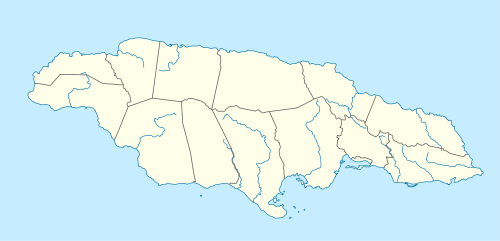Falmouth, Jamaica
| Falmouth | |
|---|---|
| Historic Town | |
 Falmouth | |
| Coordinates: 18°29′24″N 77°39′40″W / 18.490°N 77.661°WCoordinates: 18°29′24″N 77°39′40″W / 18.490°N 77.661°W | |
| Country | Jamaica |
| Parish | Trelawny |
| Founded | 1769 |
| Founded by | Thomas Reid |
| Named for | Falmouth, Cornwall, England |
Falmouth is the chief town and capital of the parish of Trelawny in Jamaica. It is situated on Jamaica's north coast 18 miles east of Montego Bay. It is noted for being one of the Caribbean's best-preserved Georgian towns.
Founded by Thomas Reid in 1769, Falmouth flourished as a market centre and port for forty years at a time when Jamaica was the world's leading sugar producer.[1] It was named after Falmouth, Cornwall in England, the birthplace of Sir William Trelawny the Governor of Jamaica who was instrumental in its establishment.
The town was meticulously planned from the start, with wide streets in a regular grid, adequate water supply, and public buildings. It even had piped water before New York City.
History
During the late eighteenth and early nineteenth centuries, Falmouth was one of the busiest ports in Jamaica. It was home to masons, carpenters, tavern-keepers, mariners, planters and others. It was a wealthy town in a wealthy parish with a rich racial mix. Within the parish, nearly one hundred plantations were actively manufacturing sugar and rum for export to Britain. Jamaica, during this period, had become the world's leading sugar producer.
All the above made Falmouth a central hub of the slave trade and the now notorious cross-Atlantic triangular trade, with its economy largely based on slavery. In Falmouth Harbour as many as 30 tall-ships could be seen on any given day, many of them delivering slaves transported under inhumane conditions from Africa and loading their holds with rum and sugar manufactured by slave labour on nearby plantations.
As a result, starting in 1840, Falmouth's fortunes as a commercial centre declined after the emancipation of slaves in the British Empire. This decline and lack of support for development has left many of its early buildings standing. The streets are lined with many small houses known for their unique fretwork and windows, major merchant and planter complexes, and commercial buildings, all dating from 1790 to 1840.
While Falmouth saw little commercial advancement after the 1840s, houses continued to be built. The town's buildings, the old and the not-so-old, make up the historic townscape of Falmouth. These shared characteristics weave the varied building styles into a distinctive pattern of early Jamaican architecture, and a critical mass of each variety makes the town an unusually distinctive place.
Places of interest include: the Albert George Shopping and Historical Centre, dating from 1895; the former residence of slave owner John Tharp; the town house of plantation owner Edward Barrett; and the St Peter's Anglican Church, built in 1795.
Infrastructural development
A new $180 million port was built to accommodate the newest and largest cruise ships, including Royal Caribbean International's Oasis class. The port opened in early 2011 [2]
Falmouth was the site of the opening ceremony for the ICC 2007 Cricket World Cup. The ceremony was held in the newly constructed Greenfield Stadium about 3 miles from the town centre.[3]
Notable people
The following Falmouth natives have had a significant impact on the cultural or socio-political landscape of Jamaica:
- Usain Bolt - (Sprinter) Olympian and world record holder.
- Ben Johnson (sprinter) - Olympian and former world record holder.
- Ky-Mani Marley - Reggae artist and Son of Bob Marley.
Anita Belnavis - Former Jamaica and Caribbean table tennis champion, Mother of Ky-Mani Marley.
- Rex Nettleford - Rhodes Scholar, Academic, former Vice Chancellor of the University of the West Indies.
- Hugh Shearer - Former Prime Minister of Jamaica.
Historic architecture
Falmouth has a number of interesting historic buildings in the Jamaican Georgian architectural style which are in need of preservation and restoration. One organisation that has taken an interest in this work is Falmouth Heritage Renewal (falmouthjamaica.org), a United States-based non-profit organization.[4]
Buildings of note include:
- Falmouth Court House
- St Peter's Anglican Church is one of the oldest in Jamaica.[5] Its supporting columns are of solid mahogany and its floor is inlaid with crosses of mahoe and mahogany.
- Falmouth All-Age School is housed in a former army barracks, Fort Balcarres.[6]
- Greenwood Great House (which once belonged to the Barretts of Wimpole Street, London) now houses the largest collection of rare musical instruments in the island.[7]
- Falmouth Post Office which is located on Market Street. It is in need of repair, but is still a functioning building from the Georgian era. A number of old colonial buildings on Market Street are from this period, however, they have not been kept in good condition throughout the years and are generally in a state of decay.
References
Further reading
External links
| Wikimedia Commons has media related to Falmouth, Jamaica. |
| ||||||||||||||||||||||||||||||||||||||||||||||||||||||||||||||||||||||||